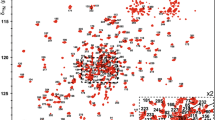Abstract
The SPOUT family of methyltransferase proteins is noted for containing a deep trefoil knot in their defining backbone fold. This unique fold is of high interest for furthering the understanding of knots in proteins. Here, we report the 1H, 13C, 15N assignments for MTT Tm , a canonical member of the SPOUT family. This protein is unique, as it is one of the smallest members of the family, making it an ideal system for probing the unique properties of the knot. Our present work represents the foundation for further studies into the topology of MTT Tm , and understanding how its structure affects both its folding and function.


Similar content being viewed by others
References
Andrews BT, Capraro DT, Sulkowska JI, Onuchic JN, Jennings PA (2013) Hysteresis as a marker for complex, overlapping landscapes in proteins. J Phys Chem Lett 4(1):180–188
Badger J et al (2005) Structural analysis of a set of proteins resulting from a bacterial genomics project. Protein: Struct Funct Genet 60(4):787–796
Burban J, Haglund E, Capraro DT, Jennings JA (2015) Heterogeneous side chain conformation highlights a network of interactions implicated in hysteresis of the knotted protein, minimal tied trefoil. J Phys 27(27):354108. http://iopscience.iop.org/0953-8984/27/35/354108
Capraro DT, Jennings PA (2016) Untangling the influence of a protein knot on folding. Biophys J 110(5):1044–1051
Cavanagh J, Fairbrother WJ, Palmer III AG, Rance M, Skelton NJ (2007) Protein NMR spectroscopy: principals and practice. Elsevier Academic Press, London. http://www.amazon.fr/Protein-NMR-Spectroscopy-Principles-Practice/dp/012164491X
Christian T et al (2016) Methyl transfer by substrate signaling from a knotted protein fold. Nat Struct Mol Biol. http://www.nature.com/doifinder/10.1038/nsmb.3282
Dabrowski-Tumanski P, Niemyska W, Pasznik P, Sulkowska JI (2016) LassoProt: server to analyze biopolymers with lassos. Nucleic Acid Res 44(W1):W383–W389
Delaglio F et al (1995) NMRPipe: a multidimensional spectral processing system based on unix pipes. J Biomol NMR 6(3):277–293
Farrow NA et al (1994) Backbone dynamics of a free and phosphopeptide-complexed SRC homology 2 domain studied by 15 N NMR relaxation. Biochemistry 33(19):5984–6003
Goddard TD, Kneller DG n.d. SPARKY 3. University of California, San Francisco
Hsieh SJM, Mallam AL, Jackson SE, Hsu STD (2014) Backbone NMR assignments of a topologically knotted protein in urea-denatured state. Biomol NMR Assign 8(2):439–442
Jamroz M et al (2015) KnotProt: a database of proteins with knots and slipknots. Nucleic Acid Res 43(D1):D306–D314
Lai YL, Chen CC, Hwang JK (2012) pKNOT v.2: the protein knot web server. Nucleic Acid Res 40(W1):W228–W231
Mallam AL, Jackson SE (2005) Folding studies on a knotted protein. J Mol Biol 346(5):1409–1421
Mallam AL, Jackson SE (2007) A comparison of the folding of two knotted proteins: ybea and yibk. J Mol Biol 366(2):650–665
Shen Y, Bax AD (2013) Protein backbone and sidechain torsion angles predicted from NMR chemical shifts using artificial neural networks. J Biomol NMR 56(3):227–241
Taylor WR (2000) A deeply knotted protein structure and how it might fold. Nature 406:916–919
Tkaczuk K, Dunin-Horkawicz S, Purta E, Bujnicki JM (2007) Structural and evolutionary bioinformatics of the spout superfamily of methyltransferases. BMC Bioinform 8:73
Wang Y, Jardetzky O (2002) Probability-based protein secondary structure identification using combined NMR chemical-shift data. Protein Sci 11(4):852–861
Wang I, Chen SY, Hsu STD (2015) Unraveling the folding mechanism of the smallest knotted protein, MJ0366. J Phys Chem B119(12):4359–4370
Wurm, Philip J et al (2009) backbone resonance assignments of the 48 kda dimeric putative 18s rrna-methyltransferase nep1 from Methanocaldococcus jannaschii. Biomol NMR Assign 3(2):251–254
Acknowledgements
We would like to thank Dominique Capraro and Xuemei Huang for insightful scientific discussions and expertise on NMR. This work was supported by the UCSD Molecular Biophysics Training Program (National Institutes of Health GM008326) and the San Diego Fellowship (D. J. B.) and funded by the National Science Foundation (PHY-1614407 and PHY-1212312 to P.A.J.).
Author information
Authors and Affiliations
Corresponding author
Ethics declarations
Conflict of interest
The authors declare that they have no conflict of interest.
Ethical standards
All experiments outlined here are in compliance with the laws of the United States of America.
Rights and permissions
About this article
Cite this article
Burban, D.J., Jennings, P.A. Backbone assignments for the SPOUT methyltransferase MTT Tm , a knotted protein from Thermotoga maritima . Biomol NMR Assign 11, 151–154 (2017). https://doi.org/10.1007/s12104-017-9737-8
Received:
Accepted:
Published:
Issue Date:
DOI: https://doi.org/10.1007/s12104-017-9737-8




